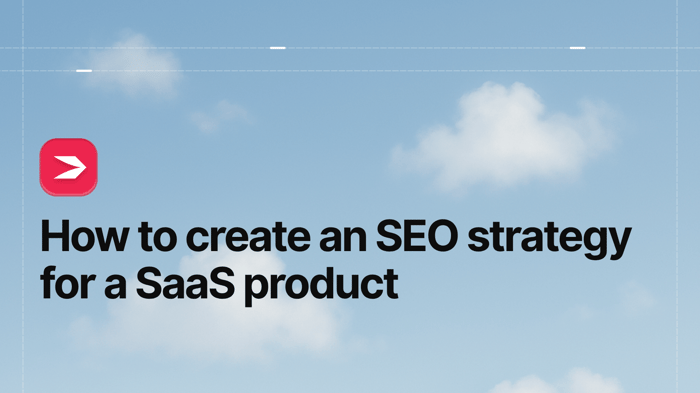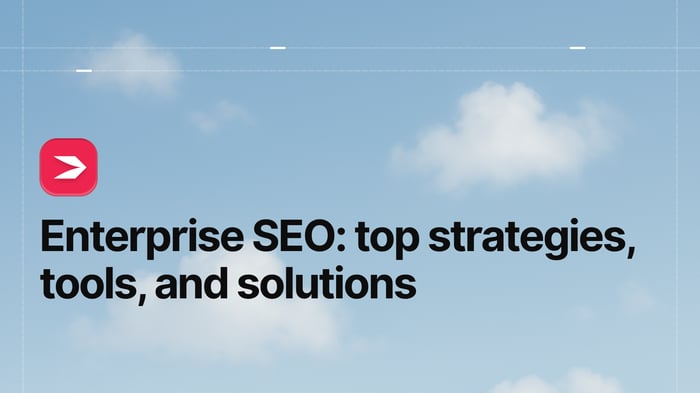A good SEO strategy can significantly drive growth, regardless of your industry. However, SaaS companies often have larger budgets, and it can be tempting to head straight towards paid marketing options – but this would be a mistake.
In reality, there can be a lot to gain from content marketing with a solid SEO strategy. You’ll certainly notice a difference when it comes to ROI because content marketing is incredibly cost-effective.
In this post, we’re going to go through the finer details to help you put together a quality SEO strategy for your SaaS product. With any luck, your product will be skyrocketing to success like many others have.
Table of Contents
Identify Your Goals
Developing an SEO strategy is like any project, and at the beginning, you need to set goals. What is it that you want to achieve with this SEO strategy? Are you hoping to improve conversion rates? Do you want to increase organic traffic? Or maybe you want to strengthen your domain authority? These are all valid goals and ones you can achieve with a good SEO strategy.
That said, any good project plan would be incomplete without metrics to measure success. At this point in the development of your strategy, you need to identify how you will monitor progress and know when your goals have been achieved.
Understand Your SaaS Product and Target Market
It’s to be expected that you would have an intricate knowledge of your SaaS product, so you need to think about its unique selling points from the perspective of a customer. This is going to be much easier if you have a good understanding of who your target audience is in terms of demographics. Conducting market research, creating buyer personas, and engaging with potential users are all helpful methods for understanding your target market.
By merging your product knowledge with a solid understanding of your audience, you can tailor your SEO strategy to your customers. Once you understand their needs and pain points, you can show them how your product can solve their problems.
Who Are Your Competitors?
The competition is a big deal, and you need to know, firstly, who your competitors are and, secondly, what they have to offer. Your customers will be looking for a particular product, and there will come a point where they’ll have to make a decision between two or more products. You need to know how your SaaS product stacks up against the rest.
It’s also helpful from an SEO perspective to know which keywords your competition is targeting. You can either decide to go head-to-head with them or identify keywords that present an easier opportunity to rank with.
Keyword Research and Topics
Keywords are the search terms users enter to find the desired information in a search engine. Search engines use keywords to help understand your content and match it with search intent – so they are the backbone of your content.
As an online business, you want your pages to show up on the first page of the SERPs. The majority of internet users don’t click past the first page, so it’s important to aim for the first page. However, not all keywords related to your product will give you the same results.
It’s worth spending a bit of time thoroughly researching the best keywords to use, looking at the keyword difficulty score and search volume as indicators. Ideal keywords have low competition and a high search volume.
Keyword research is typically interconnected with selecting blog post topics, and it’s always good to have a collection of blog post topics saved for a rainy day. Make use of your keyword research to uncover relevant keywords and phrases that your target audience is searching for. These keywords serve as the foundation for blog topics that address customer needs.
Evergreen blog content is great for consistently driving traffic and is considered to be low-maintenance. This content only needs some minor updates and can be reposted time and time again. Comparison posts are also ideal for SaaS products. People will want to understand how your product is better than another, and they’ll be specifically searching for this information.
Develop a Keyword Strategy
There are a range of tools available online for keyword research, and some of these are free, while others require a paid subscription to use. It goes without saying that the paid options will give you better results with a deeper analysis of the keywords, but it’s still possible to complete your keyword research with a free online tool.
The process for developing a keyword strategy and list of target keywords should include the following points:
- Identify relevant keywords and phrases that potential customers might use to search for solutions like yours.
- Select a list of high-volume, low-competition keywords specific to your niche.
- Prioritize keywords based on factors like search volume, relevance to your product, and user intent.
- Segment your keywords into groups or themes that align with different aspects of your SaaS product.
Optimize Systematically
Develop a process to follow for optimizing on-page SEO for all your content. Make sure you include things like a meta title, meta description, and heading tags, and consider keyword density. Every bit of content you produce needs to be optimized for best results, and a checklist is a helpful way of ensuring this happens.
There are plenty of SEO tools available online, but the best option to go with is a blogging platform that has a built-in SEO tool. DropInBlog has a built-in SEO Analyzer, and the platform makes it super easy to create and manage all your content.
It’s got all the SEO features you need to excel and produce professional blog content – you can manage multiple authors, pin a featured post, include social sharing buttons, optimize URLs, and add schema markup to your pages. Additionally, you can improve your content’s visibility in AI searches with DropInBlog’s Mention Boost™.

Technical SEO
Technical SEO is quite important because your customers will be deterred from your product if your website indicates poor performance. A fast-loading website that is user-friendly shows professionalism with software, and that’s where the customer will feel most comfortable spending their money.
Social Proof to Build Confidence
Social proof includes both your self-promotion across social media channels and the ability of past customers to review and share your product. People take reviews very seriously, and not making reviews visible can be seen as a bad thing.
When you’re starting to build a new SaaS company, you’ll have no background or reputation to work with, but reviews from your first few customers will be worth their weight in gold at this point.

Monitoring and Evaluation for Success
Regularly tracking SEO performance is essential to assess the effectiveness of your efforts and make data-driven adjustments.
Utilize tools like Google Analytics to measure organic traffic, click-through rates, conversion rates, and keyword rankings. You should also keep an eye on user engagement metrics, such as bounce rates and time on page. This helps you understand if customers are enjoying your content and getting the user experience you intend them to have.
Additionally, you can audit your pages and entire website for the performance of individual keywords and technical SEO issues. This way, you’ll know it continues to attract search results, remains mobile-friendly, and is optimized for user experience.
If you aren’t monitoring the impact of your SEO, there’s almost no point in having developed an SEO strategy. Regular evaluation of these metrics and making small changes along the way will keep your SEO strategy up to speed with any algorithm changes. A healthy SEO strategy will drive sustained growth for your SaaS product.
FAQs
Why is an SEO strategy so important for SaaS products?
SaaS products rely heavily on digital marketing, so it’s crucial to build a customer base and a following in order to secure sales. A clear, well-defined SEO strategy is often one key part of a successful SaaS product.
Is SEO for SaaS products any different from other industries?
SEO is broadly the same for every industry type. However, with SaaS products, the customer is searching for a solution to their problem, so you need to show them how your product can resolve that. Highlight the unique selling points of the product, include social proof for credibility, and make sure your technical SEO is up to scratch.
Final Thoughts
At first, you may have thought it difficult to create an SEO strategy for a SaaS product, but it’s nothing that can’t be achieved without following a careful process. It all starts with some planning and a deep dive into your customer base and competitors. But, through meticulous keyword research, content optimization, and continuous monitoring, you can create a robust SEO strategy.
A healthy SEO strategy can be adapted for algorithm changes and will continue to ensure you get organic traffic and the revenue growth you seek for years to come.





